Telstra Bundle
Who Really Owns Telstra?
Understanding the Telstra SWOT Analysis is crucial, but have you ever wondered about the very foundation of this telecommunications giant? The Telstra company has a fascinating history, evolving from government control to its current status as a publicly traded entity. Unraveling Telstra's ownership reveals key insights into its strategic direction and future prospects.
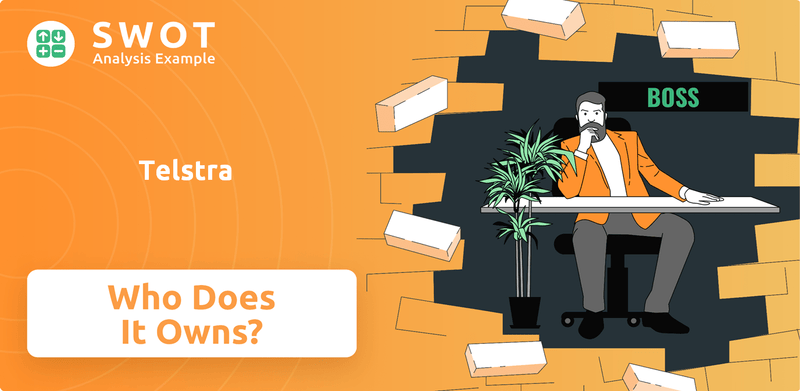
From its origins in the Postmaster-General's Department to its modern-day operations, the Telstra structure has undergone a significant transformation. This article will dissect Telstra Australia's ownership, exploring the key players behind the scenes and answering questions like: Who owns Telstra? We'll examine the evolution of its shareholder base, including Telstra shareholders, and the influence of its board of directors. This deep dive will provide a comprehensive understanding of how Telstra ownership shapes its operations and strategic decisions, providing valuable insights for investors and business strategists alike.
Who Founded Telstra?
The story of Telstra's beginnings differs from many companies. Instead of individual founders, its roots are in the Australian government. The company's story starts with the Postmaster-General's Department (PMG) in 1901, after Australia's federation.
The PMG, a government body, handled all domestic phone, telegraph, and postal services. Because it was government-owned, there were no private shareholders or early investors at the start. This structure was designed to ensure the nation had a telecommunications network.
In 1975, the PMG's telecom functions split, creating Telecom Australia and Australia Post. Telecom Australia, like its predecessor, was a government-owned corporation. The Overseas Telecommunications Commission (OTC), which managed international communications, was also a separate government entity.
Telstra's early years were defined by government ownership. This model prioritized public service and infrastructure development.
The merger of Telecom Australia and OTC in 1992 marked a significant change, leading to the formation of AOTC.
The AOTC was renamed Telstra Corporation Limited in 1993, and the trading name became Telstra in 1995, creating the brand known today.
The government's ownership aimed to provide telecommunications services across Australia, especially in remote areas.
Throughout its early stages, Telstra was wholly owned by the Australian government, reflecting a commitment to national control.
The journey from government entity to a publicly traded company involved significant changes in ownership and structure.
In February 1992, Telecom Australia merged with the OTC to form the Australian and Overseas Telecommunications Corporation (AOTC). This entity was later renamed Telstra Corporation Limited in 1993, with the domestic trading name changing to Telstra in 1995. Throughout these early stages, Telstra remained fully owned by the Australian government. This Telstra's marketing strategy was to provide services across Australia, connecting the vast regions of the country. This early structure is key to understanding the current Telstra ownership and how the company has evolved.
Telstra's ownership history began with the Australian government, not individual founders, reflecting a focus on national infrastructure.
- The Postmaster-General's Department (PMG) was the foundation, established in 1901.
- Telecom Australia and the Overseas Telecommunications Commission (OTC) were later formed as government-owned entities.
- The merger of Telecom Australia and OTC led to the creation of AOTC, later renamed Telstra.
- Throughout these changes, Telstra remained fully owned by the Australian government.
Telstra SWOT Analysis
- Complete SWOT Breakdown
- Fully Customizable
- Editable in Excel & Word
- Professional Formatting
- Investor-Ready Format
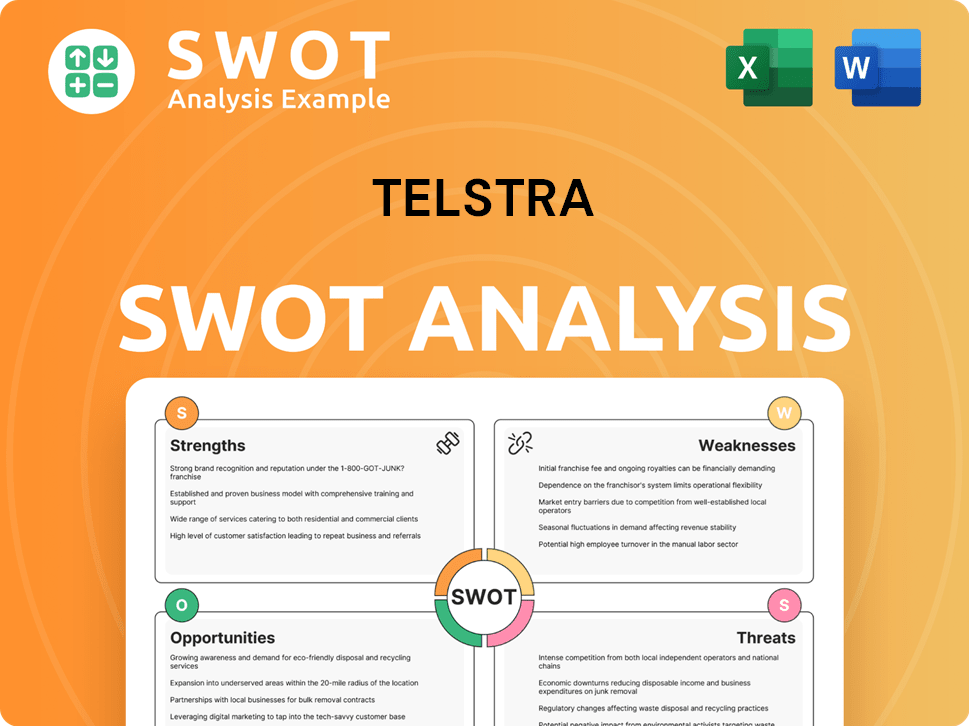
How Has Telstra’s Ownership Changed Over Time?
The evolution of Telstra ownership reflects a significant shift from government control to a publicly traded entity. The privatization process, which began in 1997, involved a series of public share offers designed to reduce government ownership and introduce private investment. This transition has fundamentally reshaped the Telstra structure and its operational strategies.
The initial public offering, known as T1, occurred in November 1997, selling approximately one-third (33.3%) of Telstra's shares. Subsequent offerings, T2 in 1999 and T3 in 2006, further reduced the government's stake. The final sale of government shares in 2006 and subsequent sales by the Future Fund in 2011 effectively completed the privatization, transforming Telstra into a fully privatized company. This transition has significantly impacted how Telstra operates, shifting its focus to market-driven strategies.
| Offering | Date | Percentage of Shares Sold | Amount Raised |
|---|---|---|---|
| T1 | November 1997 | 33.3% | A$14 billion |
| T2 | October 1999 | 16.6% | A$16.0 billion |
| T3 | November 2006 | 34.1% | A$15.5 billion (US$11.9 billion) |
Today, Telstra is a publicly traded company listed on the Australian Securities Exchange (ASX) under the ticker symbol TLS. With over one million shareholders, it is the most widely held company on the ASX. Key institutional investors include State Street Global Advisors, Inc. (6.12%), and BNP Paribas Arbitrage Sa, Asset Management Arm (4.63%). The shift in ownership has driven Telstra to become a market-driven telecommunications giant. To learn more about Telstra's position in the market, you can read about the Target Market of Telstra.
Telstra ownership has evolved significantly from government control to a publicly traded model.
- Privatization began in 1997 through public share offerings.
- The Australian government no longer holds a significant stake.
- Major institutional investors now drive the company's direction.
- Telstra's focus has shifted to market-driven strategies.
Telstra PESTLE Analysis
- Covers All 6 PESTLE Categories
- No Research Needed – Save Hours of Work
- Built by Experts, Trusted by Consultants
- Instant Download, Ready to Use
- 100% Editable, Fully Customizable
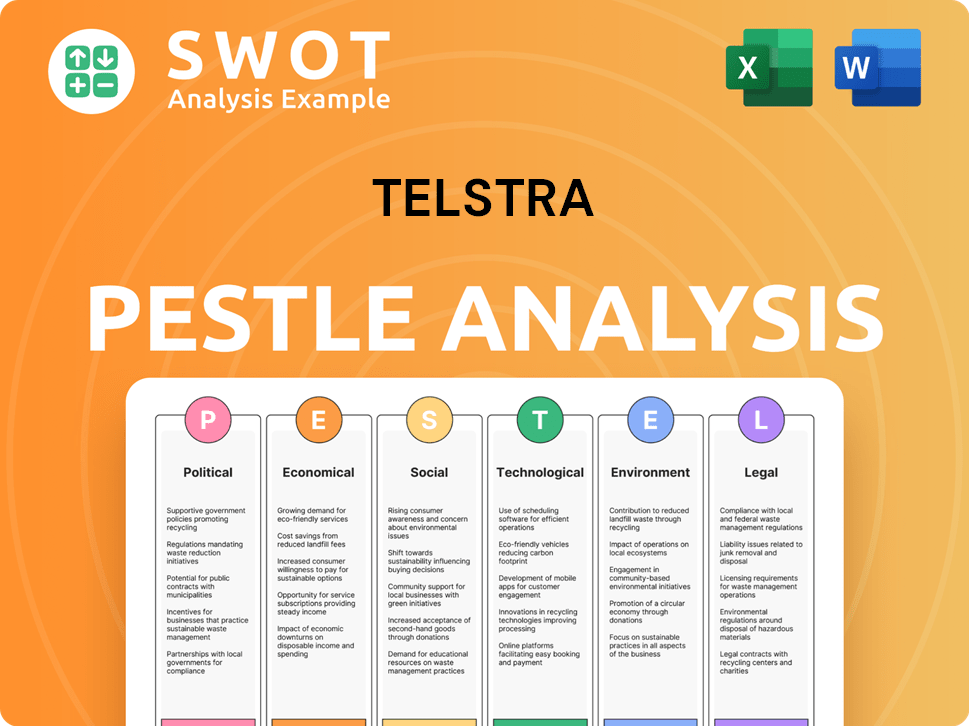
Who Sits on Telstra’s Board?
The current Board of Directors of the Telstra Group Limited is pivotal in overseeing the company, representing the interests of its diverse shareholder base. Although the specific representation of major shareholders by individual board members is not explicitly detailed in the provided search results, the board typically includes a mix of independent directors and those with significant business or industry experience. Craig Dunn currently serves as the Chairman.
The board's recent activities highlight its focus on strategic initiatives and financial performance. For example, in May 2024, Telstra announced plans to reduce its workforce by 2,800 employees to streamline operations and boost productivity, a decision overseen by the board and management. The board also demonstrated confidence in Telstra's financial outlook by approving a share buy-back program in February 2025. These actions reflect the board's commitment to enhancing shareholder value and adapting to changing market conditions. Understanding the dynamics of Telstra ownership is key to appreciating its governance structure.
| Board Member | Role | Notes |
|---|---|---|
| Craig Dunn | Chairman | Oversees board meetings and strategic direction. |
| Independent Directors | Various | Provide independent oversight and expertise. |
| Executives | Various | Bring industry experience and operational knowledge. |
Telstra operates with a one-share-one-vote structure, which is standard for a publicly listed company on the Australian Securities Exchange. This Telstra structure ensures that voting power is distributed proportionally to shareholding, promoting democratic governance among its more than one million shareholders. This structure contrasts with companies that might have dual-class shares or special voting rights. For a broader view, consider the Competitors Landscape of Telstra.
The one-share-one-vote system ensures that all Telstra shareholders have voting rights proportional to their shareholding. This structure is designed to protect shareholder interests and promote fair governance. The board's decisions, such as share buy-backs, directly impact shareholder value.
- One-share-one-vote structure.
- Board decisions impact shareholder value.
- No special voting rights exist.
- Shareholders have proportional voting power.
Telstra Business Model Canvas
- Complete 9-Block Business Model Canvas
- Effortlessly Communicate Your Business Strategy
- Investor-Ready BMC Format
- 100% Editable and Customizable
- Clear and Structured Layout
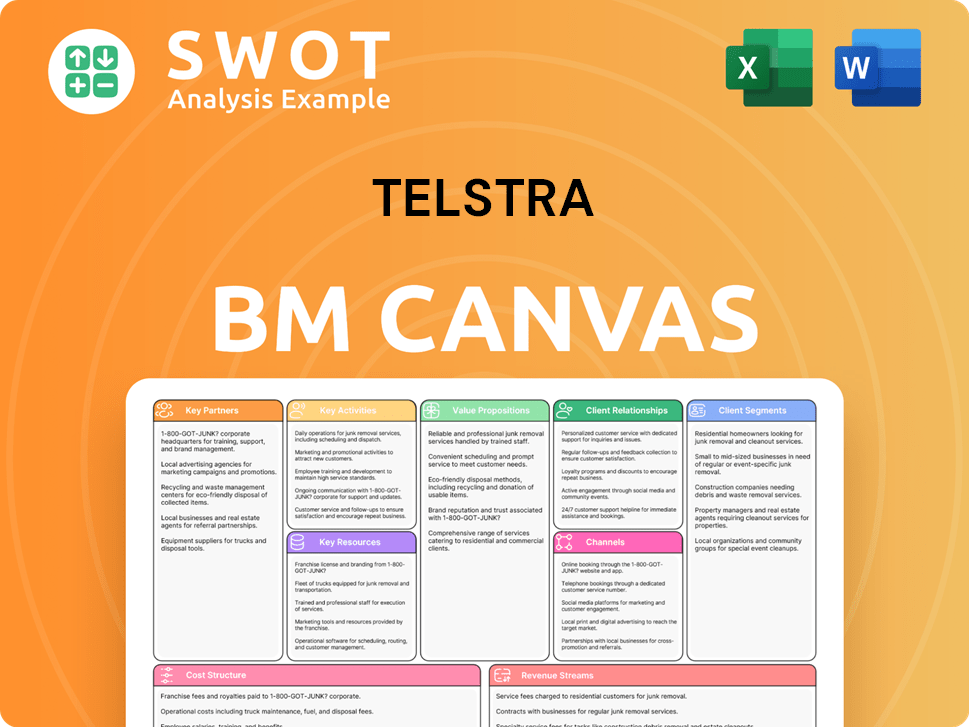
What Recent Changes Have Shaped Telstra’s Ownership Landscape?
Over the past few years, the Telstra ownership structure has seen strategic adjustments. In February 2025, the company announced an on-market share buy-back, up to A$750 million, scheduled to begin after March 12, 2025, and continue through the calendar year. This move reflects management's confidence, supporting earnings and dividend growth. This follows a history of returning capital to Telstra shareholders, including over a billion in dividends in the six months leading up to February 2025. Understanding the evolution of the company can be further explored through a Brief History of Telstra.
The leadership at Telstra company has also seen changes. Vicki Brady became the Chief Executive Officer on September 1, 2022. Oliver Camplin-Warner was promoted to Group Executive, Telstra Enterprise, in February 2024. Furthermore, Steven Worrall is set to assume the role of InfraCo CEO on September 1, 2025. These changes indicate a dynamic approach to managing and guiding the company's operations and strategic direction.
| Key Metrics | Details | Date |
|---|---|---|
| Share Buy-back | Up to A$750 million | Announced February 2025 |
| Dividend Payments | Over A$1 billion | Six months leading up to February 2025 |
| FY25 Underlying EBITDA Guidance | Between A$8.4 billion and A$8.7 billion | Projected |
Industry trends suggest an increase in institutional ownership of Telstra Australia. Major asset managers hold significant stakes, influencing the Telstra structure. The company is focused on its 'Connected Future 30 Strategy,' discussed at the Investor Day on May 27, 2025, which leverages its leadership in mobile and digital infrastructure. Telstra is also adapting to technological shifts, including the phasing out of 2G and 3G networks by October 2024, focusing on 4G LTE and 5G mobile services.
The share buy-back of up to A$750 million, announced in February 2025, is a key financial strategy.
Changes in leadership, including the appointment of new CEOs, reflect strategic adjustments.
The 'Connected Future 30 Strategy' highlights Telstra's strategic direction and technological focus.
The FY25 Underlying EBITDA guidance between A$8.4 billion and A$8.7 billion shows financial expectations.
Telstra Porter's Five Forces Analysis
- Covers All 5 Competitive Forces in Detail
- Structured for Consultants, Students, and Founders
- 100% Editable in Microsoft Word & Excel
- Instant Digital Download – Use Immediately
- Compatible with Mac & PC – Fully Unlocked
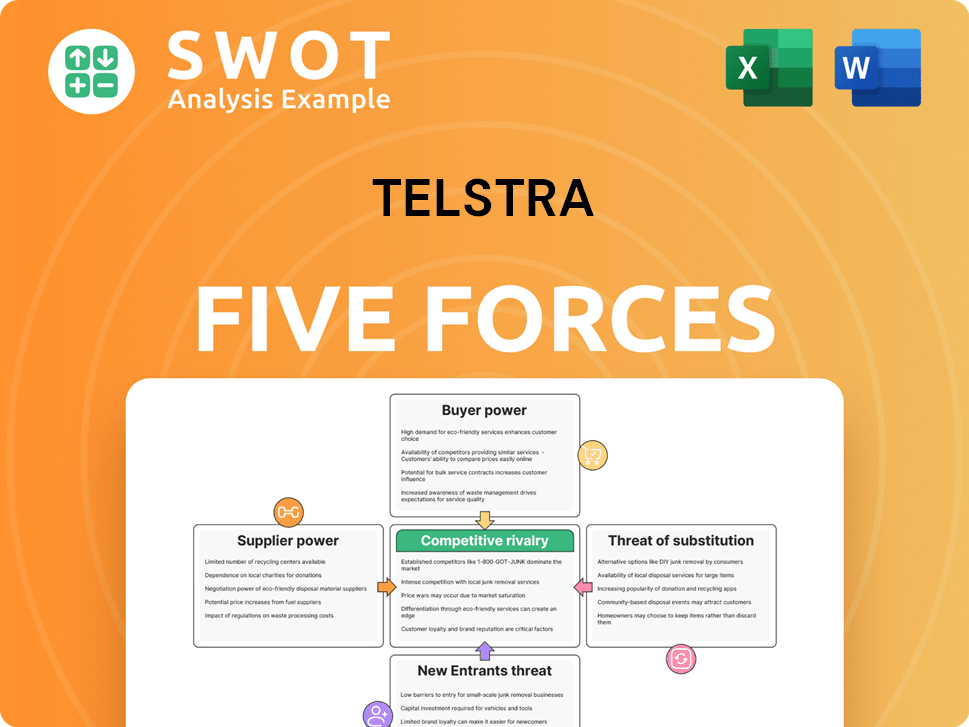
Related Blogs
- What are Mission Vision & Core Values of Telstra Company?
- What is Competitive Landscape of Telstra Company?
- What is Growth Strategy and Future Prospects of Telstra Company?
- How Does Telstra Company Work?
- What is Sales and Marketing Strategy of Telstra Company?
- What is Brief History of Telstra Company?
- What is Customer Demographics and Target Market of Telstra Company?
Disclaimer
All information, articles, and product details provided on this website are for general informational and educational purposes only. We do not claim any ownership over, nor do we intend to infringe upon, any trademarks, copyrights, logos, brand names, or other intellectual property mentioned or depicted on this site. Such intellectual property remains the property of its respective owners, and any references here are made solely for identification or informational purposes, without implying any affiliation, endorsement, or partnership.
We make no representations or warranties, express or implied, regarding the accuracy, completeness, or suitability of any content or products presented. Nothing on this website should be construed as legal, tax, investment, financial, medical, or other professional advice. In addition, no part of this site—including articles or product references—constitutes a solicitation, recommendation, endorsement, advertisement, or offer to buy or sell any securities, franchises, or other financial instruments, particularly in jurisdictions where such activity would be unlawful.
All content is of a general nature and may not address the specific circumstances of any individual or entity. It is not a substitute for professional advice or services. Any actions you take based on the information provided here are strictly at your own risk. You accept full responsibility for any decisions or outcomes arising from your use of this website and agree to release us from any liability in connection with your use of, or reliance upon, the content or products found herein.